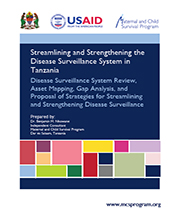The Government of Tanzania adopted the Integrated Disease Surveillance and Response (IDSR) system as the platform for all disease surveillance activities in the country. Today, Tanzania’s IDSR guidelines include surveillance and response protocols for 34 diseases and conditions of public health importance. They outline, in detail, necessary recording and reporting procedures and activities to be taken at all levels of the health system to achieve timely detection, investigation, and response to outbreaks and emergencies, and avert disease and mortality.
Over the years, IDSR procedures and the structures that support them have received significant government and external resources to maintain and strengthen detection, notification, reporting, and analysis of surveillance information. However, with the imminent phasing out of programs (such as the Global Polio Eradication Initiative program) that have supported vaccine-preventable disease (VPD) surveillance system strengthening and maintenance in the past, resources for surveillance will become more limited, and the government will need to identify additional resources to sustain the country’s essential surveillance functions.
With this in mind, between February and August 2018, the Ministry of Health, Community Development, Gender, Elderly, and Children (MOHCDGEC) and the US Agency for International Development (USAID)-funded Maternal and Child Survival Program (MCSP) undertook activities to generate information upon which future plans to strengthen Tanzania’s disease surveillance system can be based. JSI, MCSP. 2019.


